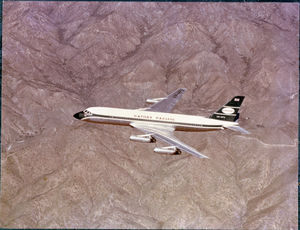VR-HFS
| VR-HFS - Convair | |
|---|---|
| VR-HFS | |

| |
| Model | Convair |
| Variation | 880-22M-3 |
| C/N | C/N 47 |
| Delivery date | 20th February 1962 |
| Length | 129'4" |
| Wingspan | 120 ft |
| Height | 36'3.75" |
| Passengers | 75-100 |
| Engines | 4 |
| Engine Builder | General Electric |
| Engine Type | CJ-805-3B turbojet |
| Engine Power | 11,650 lbf each |
| Cruise Speed | 610 mph |
| Service Ceiling | 41,000 ft |
| Empty Weight | 94,000 lb (42,730 kg) |
| Payload | 24,000 lb (10,900 kg) |
Contents
History
Cathay Pacific’s Debt to Howard Hughes
Fans of the Martin Scorsese film The Aviator may be surprised to learn that Cathay Pacific has Howard Hughes to thank for its successful evolution into the jet age – a major milestone in the airline’s history. The eccentric billionaire, movie mogul, industrialist and aviation pioneer was for many years principal stockholder in Trans World Airlines (TWA). In the mid-1950s, Hughes approached Convair – a division of General Dynamics – to come up with a design for a revolutionary new jetliner to meet TWA’s needs. At the time, Convair was lagging behind Boeing and Douglas, who were cornering the long-range commercial jet market with the B707 and DC-8 respectively, and Hughes convinced the company that there was a need for a medium-range jet that was both smaller and faster than these aircraft.
The result of the Hughes/Convair collaboration was the Convair 880: a good-looking aircraft with sharply swept back wings, four jet engines, and a slightly shorter and narrower fuselage than either the B707 or DC-8. In keeping with its intended niche market of short-to-medium-haul travel, the 880 was designed to carry less fuel than its rivals and to operate from runways as short as 5,000 feet. At Hughes’ behest, it had five, rather than six-abreast seating, offering greater levels of comfort and a total capacity (depending on configuration) of 75-100 passengers, but making it more expensive to operate. Whilst the 707 could reach maximum speeds of 560-580 miles per hour, the new aircraft’s cruising speed was 600 mph, or 880 feet per second, hence its name.
In 1956, TWA placed an order with General Dynamics for 30 of the new Convair 880 aircraft, and at the same time Hughes persuaded the manufacturer to sign a one-year exclusion contract promising the first 40 aircraft constructed to TWA and its other American launch customer, Delta. This contract effectively stymied Convair’s attempts to market the aircraft to other major carriers. Reluctant to wait in the queue, they were soon being courted by the more accommodating Boeing and Douglas. Meanwhile, as the first 18 aircraft neared completion, TWA announced that Hughes Tool, which underwrote its aircraft purchases, was in severe financial difficulties and would not be able to pay for them. Eventually the cash was found, but by the time the first of these aircraft were delivered to TWA in 1961, Howard Hughes’ problems with Hughes Tool had escalated to such an extent that his backers repossessed the aircraft, placed his 78% of TWA in a 10-year voting trust, and ousted him from control of the airline. TWA never made good on the original order from Convair.
The manufacturer was forced to seek new customers abroad, developing a variant of the 880 – the 880M – which had increased fuel capacity and engine thrust, heavier landing gear and other features designed to appeal to operators requiring greater range. At the time, Cathay Pacific was poised to expand its all propeller and turboprop fleet with the addition of jets, but hesitating over which aircraft type to choose: both the B707 and DC-8 were too large for its requirements - and also too expensive. The Convair 880M was exactly the right size, and with General Dynamics offering generous terms - immediate delivery and a knockdown price of £2.5 million (including spares), to be repaid in quarterly instalments over four years – exactly the right price.
Cathay took delivery of its first Convair 880M in 1962; a second was added in 1965, partly financed by ‘trading in’ one of its Lockheed Electra turboprops. By 1971, the airline had eight of these aircraft, all of which were acquired very cheaply, enabling Cathay to expand into the jet-age at a much faster rate than would otherwise have been financially possible. Their comfort, high speed and reliability made them very popular with passengers and every pilot wanted to fly them. However, their high fuel consumption meant that in common with most other purchasers, Cathay replaced its Convairs in the mid-70s, opting for medium range Lockheed Super TriStars, which joined a growing fleet of B707s on the long-haul routes. The Hughes debacle, which had proved a silver lining for Cathay Pacific, spelled commercial disaster for General Dynamics. Only 65 of the Convair 880/880M series were ever constructed, together with a further 35 CV990s – a larger, faster version of the 880 developed for American Airlines. Though these aircraft are often regarded as amongst the best ever built, Convair lost US$450 million on the 880/990 programme in 1962 prices – a quarter of the total value of the company.